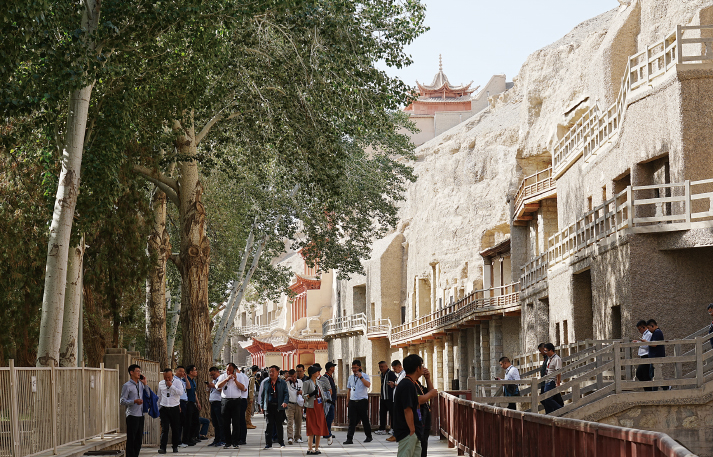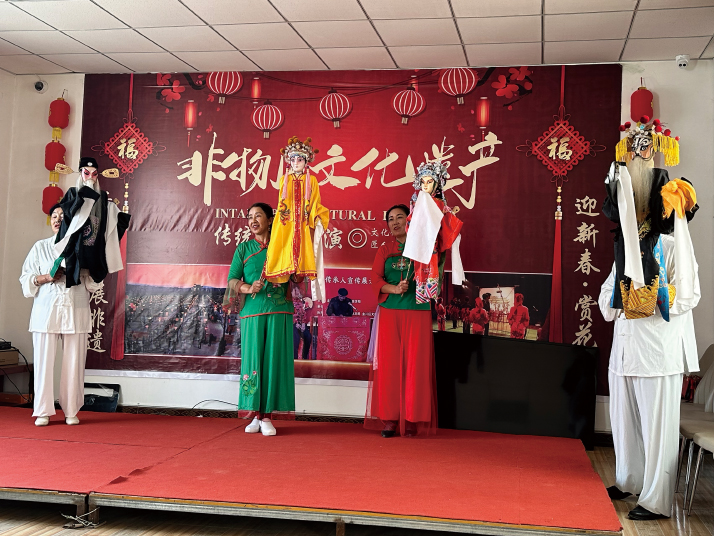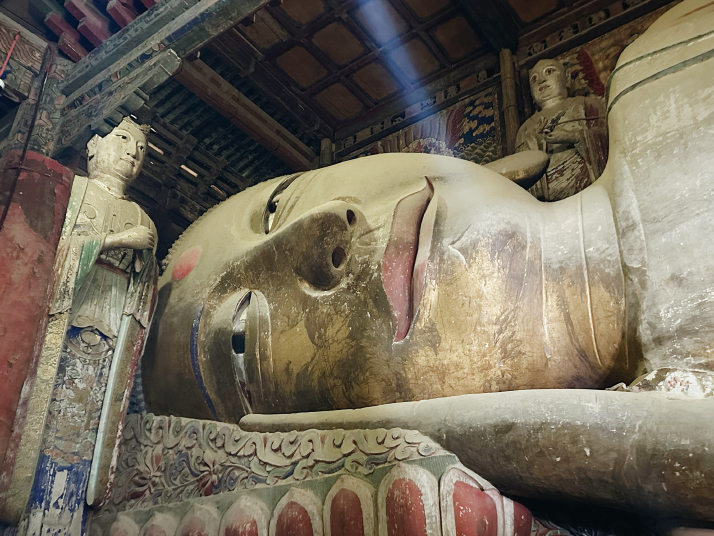Uncovering the Rich Cultural Heritage and History in Gansu

Tourists gather at the Mogao Caves in Dunhuang, Gansu Province, on September 5 (BEIJING REVIEW)
From its geological wonders to its cultural riches, the Hexi Corridor in northwestern Gansu Province is a fascinating part of the ancient Silk Road. It's the place where the Great Wall ends, and where ancient caves house historical Buddhist treasures, and some of the world's most colorful land formations impress tourists from China and around the world.
A recent journey along the historical trade route skirting the Gobi Desert in Gansu was sponsored by the China Center for International Communication Development and the Information Office of the People's Government of Gansu Province. The attraction-packed tour for foreign journalists working in Beijing culminated in the city of Dunhuang and the Sixth Silk Road (Dunhuang) International Cultural Expo.
The journalists' tour began at the Jinchuan National Mine Park in Jinchang, where rich veins of nickel and copper have earned the mine the name China's "Golden Baby." The now-depleted original open-pit mine, opened in 1959, serves as an example of the early days of mineral mining in the People's Republic of China. Eight other depleted mines have been restored and reforested to return them to their natural ecological conditions.

(Above) A traditional rod puppet performance in Maobra Village in Jinchang, Gansu Province, on September 1 A view of the giant reclining Buddha at the Big Buddha Temple in Zhangye of Gansu Province on September 2. It is said to be the largest reclining Buddha statue in China (PAMELA TOBEY)
After leaving Jinchang, our group entered and explored the earlier eras of China's intangible cultural heritage, starting with Maobra Village's Lantern City. Built in the shape of the Buddhist swastika symbol for wellbeing, the Lantern City amazes visitors with over 1,000 exquisite lanterns. Before departing, we were treated to a local Yongchang Jiezi dance and a puppet show featuring hand-operated figures dressed as classic Chinese opera characters. One of the puppeteers showed this writer how to operate one of the beautifully costumed figures, which was much harder than it looked on stage.
On the drive to Zhangye City, we glimpsed parallel stretches of the Great Wall from both the Han Dynasty (202 B.C.-A.D. 220) and the Ming Dynasty (1368-1644). The first stop in the city was at the Dafo Temple, or Big Buddha Temple, home to China's largest reclining Buddha statue, created 900 years ago during the Western Xia Dynasty (1038–1227). The statue has an interior wooden frame covered in clay that is painted and gilded and has a hidden compartment to hold Buddhist treasures. It is 34.5 meters long, with feet measuring 4 meters. He is laying in the pose of Buddha at the time of his death, with half open eyes and a calm expression. If the viewer stands at his feet, the eyes look closed, but as you walk toward his face, the eyes seem to slowly open. Marco Polo was able to visit the same statue when his family stayed in Zhangye in the 13th century. The temple complex is also home to valuable treasures of Buddhist scriptures.
Leaving the realm of Buddha, we sampled a more militaristic heritage at the Jiayuguan Pass, a fortress at the end of the Ming-era Great Wall. Construction of the pass begun in the 14th century. It took 168 years to build the fort to its current appearance. It is a well-preserved and restored military facility with a complex defense system. An inner area houses the general's office and living quarters and a two-story pavilion in the outer area was originally created as a general meeting place until the Qing Dynasty (1644-1911), when it housed civil offices. There is also a temple and opera stage that entertained the troops as well as residents and traveling merchants.
We also visited the Yulin Grottoes, named for the elm trees that grow along the river beneath the cliffs. There are 43 caves carved into eastern and western sides of the cliffs, containing painted murals and decorated sculptures. We visited six caves to see the exquisite, colorful Buddhist art. Most of the artworks were painted in the Tang (618-907) and Song (960-1279) dynasties, with one Taoist cave painted in a simpler style during the early 19th century of the Qing Dynasty. Most of the colorfully painted statues in the caves were "restored" during the Qing Dynasty, replacing the damaged delicacy and artistry of the originals with stiffer, less graceful figures. Certainly not a very accurate restoration.

A view of the giant reclining Buddha at the Big Buddha Temple in Zhangye of Gansu Province on September 2. It is said to be the largest reclining Buddha statue in China (PAMELA TOBEY)
Some of the caves have two layers of murals. The earliest, from the Tang Dynasty, are more colorful, while those from the Song have green as their main color and a more limited color palette. During the Song period, the Cao family governed the area containing the Yulin and Mogao caves for 120 years and they established a painting school to train artists to paint the murals. Of the 43 caves, roughly 30 were commissioned by the family.
Not far from the Yulin Caves is the Suoyang Ancient Relic Site, added to the UNESCO World Heritage List in 2014. At its peak, during its 1,700 years as a city, Suoyang had a population of 50,000 people. There was a large area for farming, with 90 km of irrigation canals, and it became an administrative, economic and cultural center. Today, the best-preserved elements include the inner-city walls of rammed earth with 24 defensive guard tower foundations and the Ta'er Buddhist Temple. The temple is thought to be where the famous Tang-era monk Xuanzang preached for a month in the seventh century before leaving on his pilgrimage to India. His writings about his journey inspired the famous Chinese novel Journey to the West.
Closer to Dunhuang is the more well-known cave complex, the Mogao Caves. The earliest decorated cave, number 257, dates to the fourth or fifth century and the figures depicted in its murals have a more Indian look than in the later caves, where the figures take on a more Chinese appearance. The colorful murals show shades of red, green, white and black. The figures were originally painted a pinkish color, but over time the lead in the pigment has oxidized to a dark gray.
One set of murals illustrates the story of the nine-colored deer on the bank of the River Ganges in India: A man fell in the river and was rescued by a deer with fur of nine colors. The deer asked the man to keep her location a secret as thanks for her saving him. The man returned home and learned that the emperor had had a dream about a nine-colored deer, wanted to hunt it and had offered a valuable reward. The man revealed the location and the emperor found the deer. She told the emperor the story of saving the man and his promise, and the emperor was deeply moved. He ordered that she not be hunted and the man died for breaking his promise.
Other murals contain stories of a monk who committed suicide to preserve his vows of chastity, and Lady Sumati invoking Buddha. Further inside the cave is a four-sided support pillar that acts as a stupa, around which the devout could circle in worshipful meditation. The front of the stupa has a seated statue of Sakyamuni Buddha and graceful bodhisattvas decorating the other sides.
The Tang Dynasty was the high point of painting and sculpture in the caves, including the appearance of the flying apsaras. Cave 226, usually closed to the public, illustrates the Buddhist "pure land" or paradise, with peacocks and parrots and flying instruments playing music on their own, along with illustrations of various activities in paradise. Cave 96, known as the Nine-Story Temple because of its multi-tiered outside façade, holds the site's largest Buddha, standing 35.5 meters tall and carved of sandstone covered with colorfully painted clay. The Buddha was one of many ordered to be built by the Tang Empress Wu Zetian.
The Yulin Caves, due to their remoteness, have many fewer visitors and have been better preserved than the more popular Mogao Caves closer to Dunhuang, but Mogao has taken the lead in using technology to present and preserve the caves. It leads off visits with an immersive video that surrounds the viewers and gives the feel of actually being inside the caves, which allows them to limit actual cave visits and preserve the artworks while showing their treasures. Both cave complexes are conserved and operated by the Dunhuang Academy and are inscribed on the UNESCO World Heritage List.

A performer dances with a scarf billowing on the stage during the immersive multimedia show Ancient Sound of Dunhuang on September 4 (PAMELA TOBEY)
An immersive experience of the culture of the caves is staged in the Ancient Sound of Dunhuang entertainment complex. It creates a world inspired by the 735 Mogao caves through multimedia projections coupled with beautiful costumes, music and dance. The audience navigates through several spaces in the theater. In a seating area, live action dances are performed amid the projections, culminating in graceful performers acting as flying apsaras who glide along above everyone's heads. It is as if the caves have come to life around you and you are inside the spectacular world of the mural.
Coming back down to earth, the Dunhuang Museum gives a thorough history of the region from ancient petroglyphs to the Silk Road and beyond. The first inhabitants of the area were nomadic peoples and eventually over 20 different ethnic groups lived here. As a western outpost on China's Silk Road, it was a crossroads for China and the West as well as a melting-pot of many diverse cultures. During the Yuan Dynasty (1271-1368), Silk Road trade moved to the sea and the old Silk Road, along with its outposts, began to decline. The Jiayuguan Pass was shut down by the Ming Dynasty (1368-1644) and Dunhuang was deserted for 200 years, until the Qing Dynasty sent people west to Dunhuang to rehabilitate it for farming. It eventually has grown into the art- and culture-infused city of today.
Our journey along Gansu's Hexi Corridor ended at the Sixth Silk Road (Dunhuang) International Cultural Expo, where various aspects of Gansu's intangible cultural heritage were displayed and demonstrated. Xinjiang Uygur Autonomous Region was the guest province and Turkmenistan the guest country. Booths showed examples of cultural heritage including a wide range of textile arts, floral work, paper cutting artwork, pottery, porcelain and gourd art, as well as music, publications and regional foods. At one booth, I was taught how to do a simple paper cutting by one of the master artisans of the craft, who had intricate examples of her art on display.
The Safeguarding Living Heritage for Sustainability Forum, sponsored by UNESCO, the World Bank and the Gansu Provincial Department of Culture and Tourism, was held the second day. At the opening ceremony of the forum, renowned archaeologist and Honorary President of the Dunhuang Academy, Fan Jinshi was recognized by UNESCO for her outstanding contributions to preserving and protecting the Mogao Caves. Dr. Duong Bich Hanh, Programme Specialist for Culture of UNESCO Multisectoral Regional Office for East Asia and a forum moderator, described the work of the research academy as comprehensive and data-based.
"The management structure is well-established," she said. "It has a very extensive research side."
From mineral riches to cultural heritage, our journey in Gansu spanned the breadth of China's silk road culture. The Hexi Corridor, with history-rich Dunhuang, is a model of exchange and learning between different worlds throughout history and is a melting pot of cultures that produced some of the most valuable cultural heritage of China's long history. It is a treasure chest of travel riches worth opening.